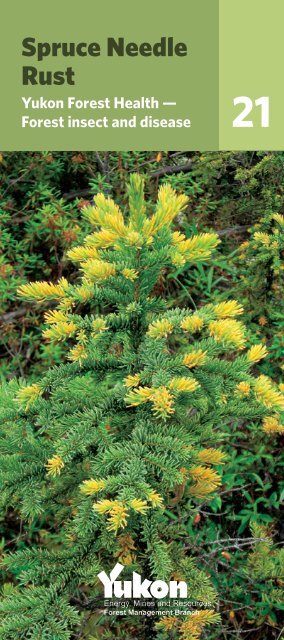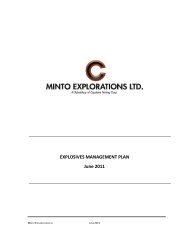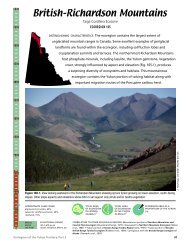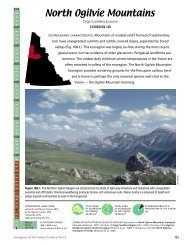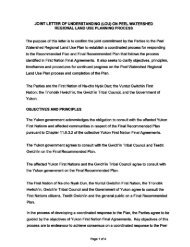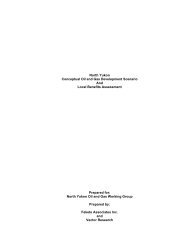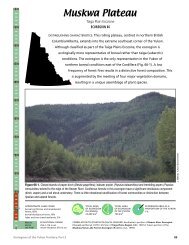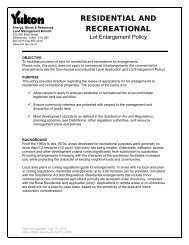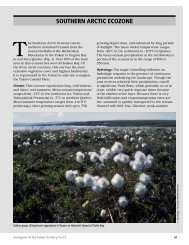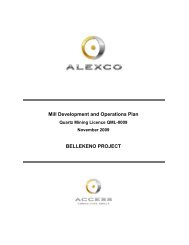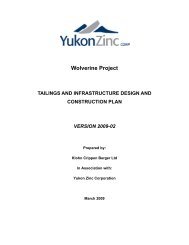Spruce Needle Rust - Energy, Mines and Resources - Government ...
Spruce Needle Rust - Energy, Mines and Resources - Government ...
Spruce Needle Rust - Energy, Mines and Resources - Government ...
You also want an ePaper? Increase the reach of your titles
YUMPU automatically turns print PDFs into web optimized ePapers that Google loves.
<strong>Spruce</strong> <strong>Needle</strong><br />
<strong>Rust</strong><br />
Yukon Forest Health —<br />
Forest insect <strong>and</strong> disease 21<br />
<strong>Energy</strong>, <strong>Mines</strong> <strong>and</strong> <strong>Resources</strong><br />
Forest Management Branch
Introduction<br />
Small-spored spruce Labrador tea rust (Chrysomyxa ledi) <strong>and</strong><br />
large-spored spruce Labrador tea rust (Chyrsomyxa ledicola)<br />
are fungal diseases affecting the current year’s needles of<br />
white spruce. The range of spruce needle rust coincides<br />
with the ranges of the aecial (primary) host, white spruce<br />
(Picea glauca) <strong>and</strong> the telial (secondary) hosts, Labrador<br />
tea (Ledum palustre <strong>and</strong> L. groenl<strong>and</strong>iculum) <strong>and</strong> leatherleaf<br />
(Chamaedaphne calyculata). These complex rust fungi are<br />
heteroecious meaning that they require the presence of<br />
both spruce <strong>and</strong> Labrador tea to complete the disease cycle.<br />
Because both species of Labrador tea only occur in moist<br />
conifer woods <strong>and</strong> peatl<strong>and</strong>s, disease incidence is limited to<br />
these areas. Chrysomyxa spp. rarely causes tree mortality <strong>and</strong><br />
symptoms manifest as defoliation of current needles resulting<br />
in twig <strong>and</strong> branch dieback. In 2008, localized patches were<br />
observed along the Long Lake Road near Whitehorse <strong>and</strong><br />
near the Morley River along the Alaska Highway. In general,<br />
wet <strong>and</strong> cool weather is conducive for spore formation <strong>and</strong><br />
spore dispersal from Labrador tea, as well as infection of new<br />
spruce needles.<br />
2
Host Range for <strong>Spruce</strong> <strong>Needle</strong> <strong>Rust</strong><br />
(Source data: Yukon <strong>Government</strong> Forest Inventory Data [2008] <strong>and</strong><br />
U.S. Geological Survey [1999] Digital representation of “Atlas of United<br />
States Trees” by Elbert L. Little, Jr. (http://esp.cr.usgs.gov/data/little/)<br />
Disclaimer: The data set for historic incidence is likely incomplete <strong>and</strong> only<br />
extends from 1994–2008. Endemic or outbreak populations may have<br />
occurred or may currently exist in non-mapped locations within the host<br />
range.<br />
Forest Health Program<br />
Forest Management Branch<br />
<strong>Energy</strong>, <strong>Mines</strong> <strong>and</strong> <strong>Resources</strong><br />
<strong>Government</strong> of Yukon<br />
P.O. Box 2703 (K-918)<br />
Whitehorse, YT Y1A 2C6<br />
867-456-3999<br />
Toll free in Yukon: 1-800-661-0408, ext. 3999<br />
www.forestry.emr.gov.yk.ca<br />
3
Disease Cycle<br />
Symptoms appear in<br />
midsummer as white<br />
blisters on the<br />
current season’s<br />
needles.<br />
Teliospores<br />
germinate <strong>and</strong><br />
produce<br />
basidiospores that<br />
infect newly<br />
emerging spruce<br />
needles.<br />
The general disease cycle of C. ledicola <strong>and</strong> C. ledi is as follows:<br />
1. Symptoms on spruce appear in midsummer as white<br />
blisters (aecia) on the surface of the current season’s<br />
needles <strong>and</strong> occasionally on cone scales.<br />
2. The blisters burst revealing yellow-orange spores<br />
(aeciospores) which disperse on the wind to the alternate<br />
host in summer.<br />
4<br />
Telia develop <strong>and</strong> rupture<br />
the epidermis of the<br />
secondary host.<br />
Windborne spores<br />
disperse to the telial<br />
host, Labrador tea.<br />
Blisters burst revealing<br />
yellow-orange aeciospores.<br />
Uredinia form, which<br />
release uredospores<br />
that can re-infect<br />
other leaves or<br />
plants of the telial<br />
host.<br />
Definitions:<br />
Uredinia: a reddish pistule-like structure that is formed on<br />
the tissue of a plant infected by a rust fungus <strong>and</strong> produces<br />
uredospores.<br />
Chlorosis: a condition in which leaves produce insufficient<br />
chlorophyll.
3. Spores l<strong>and</strong> on the alternate host, germinate <strong>and</strong> infect<br />
the leaves where they overwinter.<br />
4. Uredinia are produced on the upper surface<br />
(C. ledicola) or underside (C. ledi) of the telial host <strong>and</strong> may<br />
develop under mild, moist conditions. Uredinia produce<br />
uredospores that can re-infect other leaves or plants of<br />
the telial hosts (Labrador tea). The existence of this cycle<br />
means that spruce is not essential for the rusts’ survival.<br />
5. Under certain conditions in spring, white blisters or<br />
pustules (telia) develop on the lower (C. ledi) or upper<br />
(C. ledicola) surface of infected leaves <strong>and</strong> rupture<br />
the epidermis. This characteristic allows for the<br />
identification of rust species on the telial host.<br />
6. Yellow-orange spores (teliospores) germinate <strong>and</strong><br />
produce another type of spore (basidiospore) that<br />
disperses on the wind <strong>and</strong> infects newly emerging <strong>and</strong><br />
developing spruce needles.<br />
7. By midsummer, symptoms can be seen as in step 1.<br />
Host Species Attacked<br />
<strong>and</strong> Damage<br />
Tree species attacked in Yukon: White spruce (Picea glauca)<br />
is highly susceptible. Black spruce (Picea mariana) has low<br />
susceptibility. Seedlings, saplings <strong>and</strong> pole-sized trees are<br />
more susceptible than mature timber.<br />
On spruce, the fungus rarely causes tree mortality. The<br />
damage caused by the needle rust is for the most part<br />
cosmetic, resulting in varying degrees of defoliation ranging<br />
from single needles to the entire complement of current<br />
growth in young trees (photo 5). In older trees, infections<br />
are normally limited to branches in the lower crown. Though<br />
little research has been done on the affects of the disease,<br />
repeated infection almost certainly impairs growth, especially<br />
in young trees where the current needles constitute a higher<br />
proportion of the entire crown. Initially, a portion of the<br />
needle is infected <strong>and</strong> it develops a yellow b<strong>and</strong> parallel to<br />
the veins. As the disease progresses, infected foliage turns<br />
striking yellowish-orange then changes to reddish-brown.<br />
<strong>Needle</strong>s infected the previous year appear straw coloured<br />
<strong>and</strong> are usually shed the year after infection (photo 1). White<br />
blisters <strong>and</strong> orange aeciospores may be visible on the leaf<br />
surface (photo 2a, b <strong>and</strong> photo 3). 5
On Labrador tea <strong>and</strong> leatherleaf, localized chlorosis of leaves<br />
occurs during the initial stages of the disease (photo 4). As<br />
the fungal mycelia grow within the host tissue, <strong>and</strong> the telia<br />
form, leaves change to a yellowish colour. Eventually leaf<br />
death occurs <strong>and</strong> the leaves turn brown <strong>and</strong> are shed.<br />
Definitive identification of the aecial (spruce) stage of<br />
the rust is only possible if spores are examined under a<br />
microscope. The aeciospores of C. ledicola are larger <strong>and</strong><br />
shaped differently than those of the C. ledi. On the telial hosts<br />
(Labrador tea <strong>and</strong> leatherleaf) C. ledicola uredinia form on<br />
the upper surface of the leaves while C. ledi uredinia form on<br />
the lower surface of the leaves. The following signs are good<br />
indicators of spruce needle rusts:<br />
C. Ledicola:<br />
Small (
2a<br />
1<br />
2b<br />
3<br />
7
8<br />
Similar damage<br />
<strong>Spruce</strong> needle rust damage may appear similar to that<br />
produced by spruce broom rust (Chrysomyxa arctostaphyli)<br />
<strong>and</strong> spruce needle cast (Lirula macrospora). The cast differs<br />
from the rusts in that it affects the previous year’s needles<br />
as well as those of the current year. Infected needles are<br />
straw coloured with distinctive elongate black b<strong>and</strong>s. The<br />
initial stages of the spruce broom rust can appear similar to<br />
the needle rust; however, as the broom rust progresses it<br />
produces a unique <strong>and</strong> conspicuous branching pattern, or<br />
“witches’ broom.”<br />
4<br />
5
Risk Assessment<br />
The following tables summarize the likelihood of occurrence<br />
<strong>and</strong> magnitude of impact of an outbreak at the st<strong>and</strong> level.<br />
These tables are a coarse guide for estimating the risk of an<br />
outbreak when populations are at endemic levels.<br />
Likelihood of Occurrence<br />
St<strong>and</strong> Infection Hazard:<br />
Site moisture regime 1<br />
Labrador tea in, <strong>and</strong> adjacent to,<br />
st<strong>and</strong> 2<br />
Previous year’s summer climate 3<br />
Notes:<br />
High<br />
Wet<br />
300 m<br />
Wet, cool Dry, hot<br />
9
10<br />
Magnitude of Consequence<br />
The magnitude of consequence is a subjective assessment<br />
of the potential consequences of an outbreak. This list is not<br />
exhaustive <strong>and</strong> is intended to stimulate thought on potential<br />
impacts to consider over time.<br />
Value<br />
Traditional Use 1<br />
Comment:<br />
Visual Quality 2<br />
Timber Productivity 3<br />
Wildfire Hazard 4<br />
Public Safety 5<br />
Hydrology 6<br />
Impact<br />
- +<br />
No impact anticipated<br />
Comment: Discoloured needle period (-)<br />
Comment: Growth reduction (-)<br />
Comment: No impact anticipated<br />
Comment: No impact anticipated<br />
Comment: No impact anticipated<br />
Time Scale (years) 20+ 15 10 0-5 0-5 10 15 20+<br />
Comment: Impact refers to a predicted, substantial<br />
positive (+) or negative (-) impact on a value<br />
for an estimated time period
Notes:<br />
1. In this context, traditional use values considered are<br />
hunting, trapping <strong>and</strong> understory shrub/plant use. Given<br />
that spruce needle rust outbreaks rarely cause mortality,<br />
no impact is anticipated.<br />
2. Visual quality is negatively impacted in the two years<br />
following infection until infected needles are shed.<br />
3. Infection rarely causes tree mortality but does kill<br />
the current year’s needles, therefore growth could<br />
potentially be negatively impacted.<br />
4. Given that spruce needle rust only affects the current<br />
year’s foliage <strong>and</strong> therefore generates very little fine fuel<br />
input, no impact is anticipated.<br />
5. Given that spruce needle rust outbreaks rarely cause<br />
mortality, no impact is anticipated.<br />
6. Given that spruce needle rust outbreaks rarely cause<br />
mortality, no impact is anticipated.<br />
11
12<br />
Implications of<br />
Climate Change<br />
General Circulation Model (GCM) results in the 2007<br />
Intergovernmental Panel on Climate Change (IPCC) report<br />
indicate that warming in northern Canada is likely to be<br />
greatest in winter (up to 10°C) <strong>and</strong> warmer by 3–5°C in<br />
summer. Mean annual precipitation is also predicted to<br />
increase (particularly in fall <strong>and</strong> winter). More rainfall is<br />
expected on windward slopes of the mountains in the west,<br />
therefore the rain shadow effect of the St. Elias Mountains<br />
may mean that southern Yukon does not experience<br />
increased rainfall. High temperatures will increase levels<br />
of evaporation <strong>and</strong> transpiration, <strong>and</strong> ultimately lower<br />
soil moisture levels. Therefore, even if summer rainfall is<br />
maintained at current average levels, higher temperatures<br />
would result in limited soil water availability <strong>and</strong> cause<br />
moisture stress in trees. Currently, climate scenarios suggest<br />
that Yukon will experience a warmer climate that will be<br />
wetter or drier in the future depending on the region.<br />
Temperature <strong>and</strong> precipitation are likely to be the dominant<br />
drivers of change in pathogen abundance <strong>and</strong> tree responses<br />
as it influences pathogen development, dispersal, survival,<br />
distribution <strong>and</strong> abundance. As with other pathogens,<br />
moisture is a critical factor for spore development, dispersal<br />
<strong>and</strong> infection. Increased precipitation during the summer<br />
months would mean more successful dispersal from<br />
Labrador tea <strong>and</strong> infection of new host material. However, if<br />
temperatures are too high, then this could negatively impact<br />
spore production. A warmer, drier scenario would reduce the<br />
success of spore development, dispersal <strong>and</strong> germination.
Management Options<br />
Monitoring<br />
This disturbance agent is best monitored with annual ground<br />
surveys. The best time of year for monitoring is mid- to<br />
late summer when the foliage of last year’s attack is fully<br />
discoloured <strong>and</strong> the fruiting bodies on white spruce are most<br />
conspicuous. During this time, infected foliage should be<br />
turning to a striking yellowish-orange initially then change to<br />
reddish-brown. If foliage is straw coloured <strong>and</strong> being shed,<br />
then the damage is likely from the previous year.<br />
Direct Control<br />
Because the rust rarely causes significant damage to spruce<br />
st<strong>and</strong>s, direct control is not generally recommended.<br />
Successive years of heavy levels of infection do not<br />
commonly occur <strong>and</strong> infected needles are usually shed. If<br />
treatment is required to protect high value trees, chemical<br />
control with fungicides can be effective if application is<br />
timed with spore production. Generally, the first application<br />
should be made when 10% of the trees have broken some<br />
buds. Applications should then be made at weekly intervals<br />
until needles are mature or until symptomatic needles<br />
have dropped to the ground. As a result, three applications<br />
of fungicide are usually required. However, up to five<br />
applications of fungicide may be required in years where bud<br />
break is slow, the weather is cool, <strong>and</strong> there is enough free<br />
moisture on the needles for infection. This form of treatment<br />
is not a viable option for commercially harvested st<strong>and</strong>s, <strong>and</strong><br />
the use of fungicides should be limited because fungi can<br />
develop resistance.<br />
13
14<br />
Harvesting Considerations<br />
Harvesting of spruce may occur either as a by-product of<br />
private/industrial l<strong>and</strong> clearing or if a commercial forestry<br />
operation is undertaken. Harvesting will not likely contribute<br />
to the spread of the disease.<br />
Silvicultural Considerations<br />
Silvicultural considerations are relevant if a st<strong>and</strong> is<br />
being managed for commercial forestry or if an area is<br />
being replanted. Consider managing for increased st<strong>and</strong><br />
biodiversity by utilizing a range of preferred <strong>and</strong> acceptable<br />
species for planting <strong>and</strong> avoid planting spruce in areas with<br />
large populations of Labrador tea.
References<br />
Douglas, S. 2006. <strong>Spruce</strong> <strong>Needle</strong> <strong>Rust</strong>s in Connecticut. The<br />
Connecticut Agricultural Experiment Station (web page):<br />
http://vvv.caes.state.ct.us/FactSheetFiles/PlantPathology/<br />
fspp052f.htm<br />
Hennon, Paul E. 2001. <strong>Spruce</strong> <strong>Needle</strong> <strong>Rust</strong>. USDA, US Forest<br />
Service. Forest Leaflet R10-TP-99:<br />
www.fs.fed.us/r10/spf/fhp/leaflets/Sprneerus.htm<br />
Hiratsuka, Y. 1994. <strong>Spruce</strong> <strong>Needle</strong> <strong>Rust</strong>s. Natural Resource<br />
Canada, Canadian Forest Service, Northwest Region,<br />
Northern Forestry Centre, Edmonton, Alberta. Forest Leaflet<br />
25. 2 pp.<br />
Natural <strong>Resources</strong> Canada. 2009. <strong>Spruce</strong> <strong>Needle</strong> Cast. Insects<br />
<strong>and</strong> Diseases of Canada’s Forests (web page): http://imfc.cfl.<br />
scf.rncan.gc.ca/maladie-disease-eng.asp?geID=22&ind=S<br />
Ott, R. 2008. Trip Report for the Yukon Forest Health Survey.<br />
Unpublished report prepared for Yukon <strong>Government</strong>.<br />
15
www.forestry.gov.yk.ca


